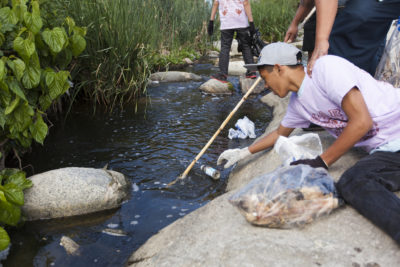Guest Blogger Stephanie Oehler: California Legislators Propose Framework to Radically Reduce Plastic Waste
Senate Bill 54 would phase out non-recyclable plastics and require more source reduction and recycling by 2030

California may soon pass new legislation that would tackle a major contributing factor to global plastic pollution – single-use plastic packaging and products. While experts continue to push for comprehensive federal legislation on plastic waste, California’s actions could have widespread benefits. State residents consume large quantities of plastics and California is often an early adopter of environmental policies that other states and jurisdictions may later follow.
State Senator Ben Allen introduced Senate Bill 54 (SB 54) last month in an effort to spur state action on plastic pollution. This week, the bill cleared the Senate Environmental Quality Committee. If passed, SB 54 would create the California Circular Economy and Plastic Pollution Reduction Act, which would require the Department of Resources, Recycling and Recovery (also known as CalRecycle), with input from the State Water Resources Control Board and the Ocean Protection Council, to design regulations that accomplish two goals in California:
(1) On the waste management side, at least 75 percent of single-use plastic products and packaging must be source-reduced or recycled by 2030; and
(2) On the production side, all single-use plastics sold and consumed must be recyclable or compostable by 2030.
The bill gives CalRecycle considerable flexibility to design regulations that achieve these substantive goals, but provides suggestions for how they might be accomplished (section 42041(c)).
It is promising that California legislators want to strengthen the state’s plastic recycling efforts. National plastic recycling rates are falling and the environmental, public health, and economic impacts attributed to the ever-increasing generation of plastic waste are worsening.
In reading the language of the bill, several thoughts came to mind about how the law would work in practice.
First, SB 54 creates an ambitious timeline that is intended to yield hugely positive results within roughly a decade. CalRecycle must develop and finalize its Scoping Plan, in consultation with other state and local agencies and the public, by January 1, 2021 (section 42044(a), (f)). At that point, it would have less than a decade to increase the recycling rate for single-use plastics in the state by roughly 60 percent (section 42041(c)).
Given the relatively short amount of time to develop and implement the Scoping Plan, CalRecycle should consult the public early and often. The public is a particularly useful resource when designing source reduction policies because it can help identify which single-use plastic items people are most willing to live without, which will be easiest to give up, and which waste streams are creating the most waste or causing the most pollution in different communities. Further, non-governmental organizations may have information that is useful to the agency, including, but not limited to, statistics on plastic waste items most frequently escaping waste streams and winding up in local waterways, or participation rates for voluntary bans on certain plastic items. In addition, individuals and organizations may serve as crucial partners in driving source reduction and recycling efforts among major producers.
Second, SB 54 could more strongly prioritize source reduction over recycling. Source reduction is the most effective way to reduce waste; CalRecycle’s own waste management hierarchy, codified in the California Public Resources Code, encourages entities to “reduce, reuse, recycle, dispose,” in that order. But source reduction can also be challenging to achieve because it requires changing consumer behavior. While SB 54 would require CalRecycle to use source reduction “to the maximum extent feasible,” it would also allow the agency to satisfy the 75 percent diversion requirement through any combination of source reduction and recycling (section 42042(a)). Given the potential difficulties associated with source reduction, I fear the agency could consider many source reduction approaches infeasible, risking heavier reliance on recycling to avoid imposing necessary but politically unpopular measures such as product bans and landfill and recycling fees. However, legislators could ensure that CalRecycle prioritizes the state’s preferred waste management approaches by requiring that a specific, significant portion of the 75 percent diversion be met through source reduction.
Third, the bill does not explicitly address the difficult logistical questions surrounding the actual recycling of plastic materials. Given the fact that a large portion of single-use plastic packaging and products will need to be recycled if the goals of the Act are met, how and where the recycling will occur seems particularly relevant in this context.
As the bill explains, until recently, California exported the majority of its recyclables to China for processing (Section 42041(d)). Due to China’s relatively new restrictions on importing recyclables, however, this is no longer an option for most plastic waste, which instead ends up in landfills or is incinerated. Nevertheless, SB 54 seeks to reduce the negative impacts of single-use plastic packaging and products, at least in part, through recycling. This topic was not directly addressed by SB 54. The bill would require CalRecycle to both offer incentives for local manufacturing using plastic waste generated by Californians and deter exports, as well as allow the agency to require reporting of exports to certain countries, but it does not task CalRecycle with developing in-state infrastructure to process recyclables (section 42042). Without such a requirement, or an alternative solution for avoiding landfills and incineration, I am unsure of how the agency can satisfy the broader goals of increasing recyclables.
Finally, the legislature suggests CalRecycle look to all relevant programs in other jurisdictions when designing its Scoping Plan (section 40244(d)). While such an inquiry would likely involve a significant amount of research on the part of the agency, and the scope of its considerations may be limited both by the relatively quick deadline imposed for finalizing the Scoping Plan and the capacity of the agency, this requirement seems to encourage the use of innovative approaches. Given the pervasiveness of single-use plastic products in our day-to-day lives, innovation and creativity will be crucial in finding practically feasible and cost-effective solutions to bring about significant reductions in a condensed time frame.
Overall, SB 54 creates a framework within which single-use plastic products and packaging would be radically reduced statewide in a relatively short period of time. Its goals are exciting, and would signal a serious commitment by one of the largest economies in the world to reduce its plastic consumption and waste production. With the inclusion of more specific source reduction goals and clarification of the state’s recycling capacity, I believe SB 54 could offer an even clearer, actionable plan for CalRecycle to implement.
Stephanie Oehler is a student at UCLA School of Law.







Reader Comments